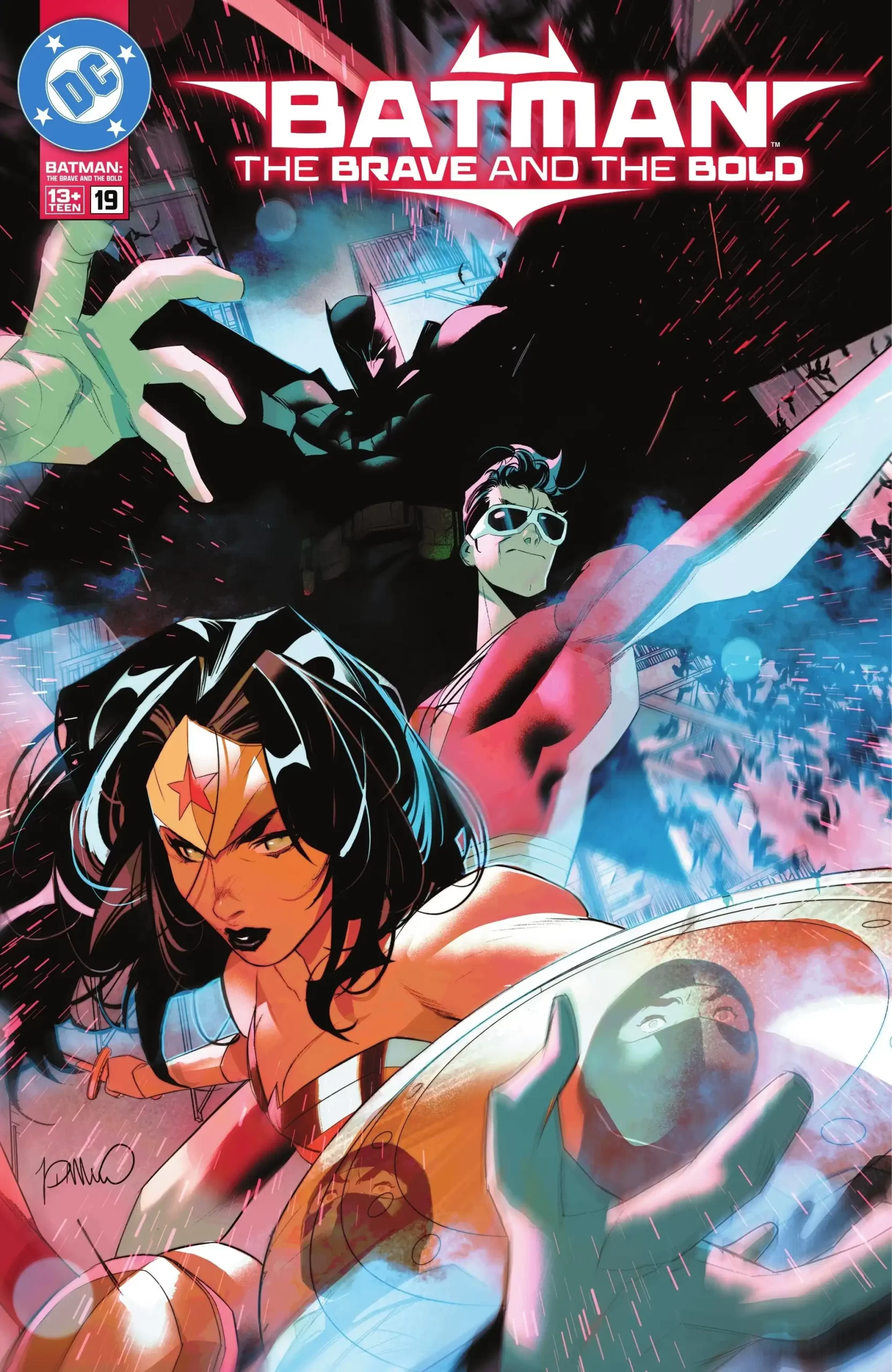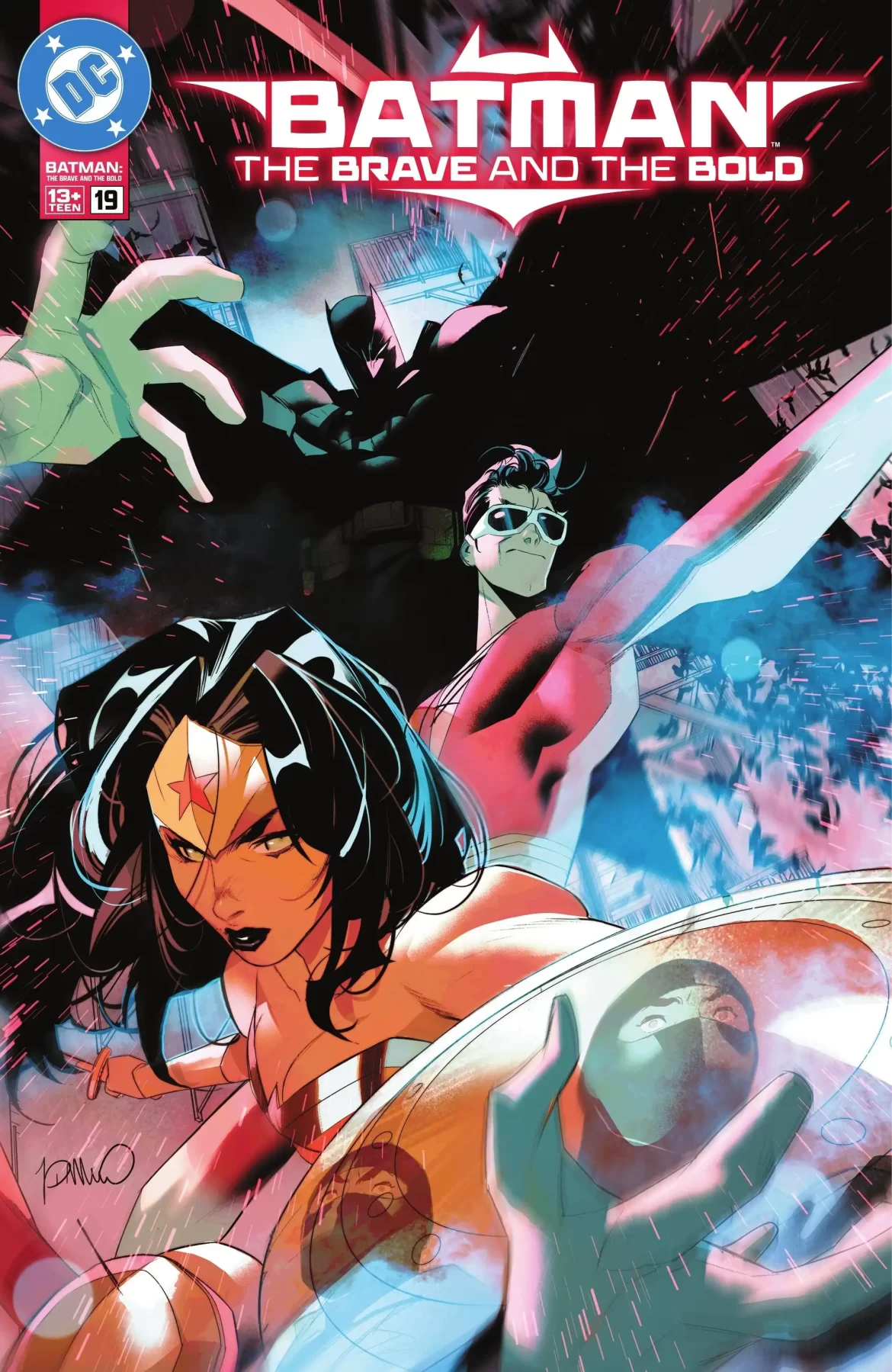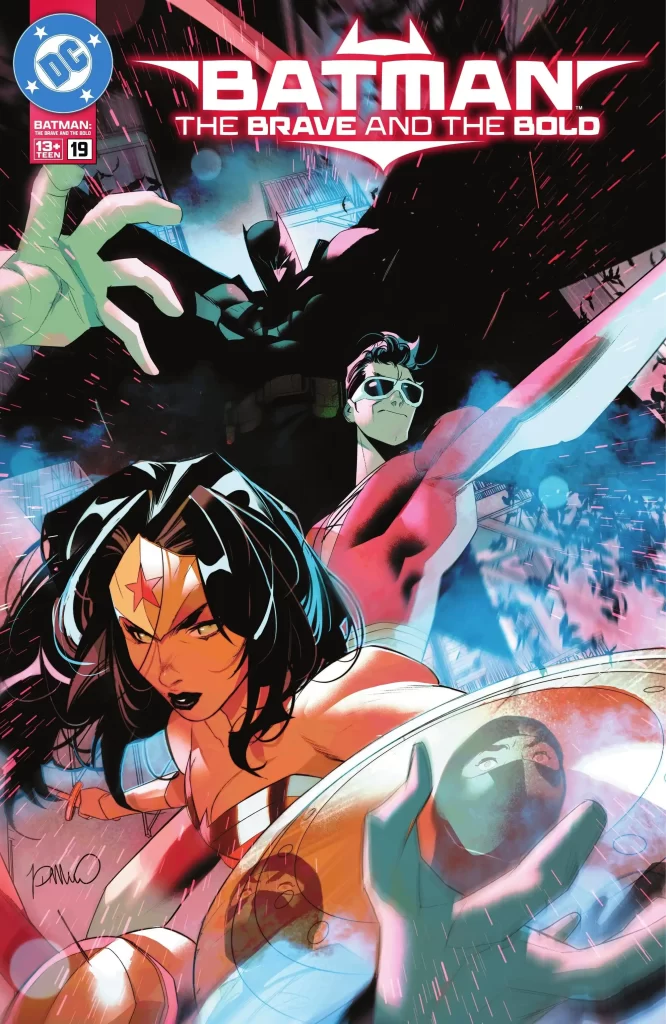In this review of Batman: The Brave and the Bold #19, Batman teams up with Scarecrow, Wonder Woman teams up with Plastic Man, Martian Manhunter teams up with Animal Man, and Robin teams up with Robin… again.
Batman: The Brave and the Bold #19
Writer: Zac Thompson, Dave Wielgosz, Michael W. Conrad, Brendan Hay, and Rich Douek
Artists: Stefano Raffaele, Nikola Čižmešija, Christopher Mitten, Marco Santucci, and Stevan Subic
Colors: Lee Loughridge, Rex Lokus, Ivan Plascencia, Luis Guerrero, and Marcelo Maiolo
Main Cover: Simone Di Meo
Variant Cover: Riley Rossmo, Stevan Subic, and McFarlane Toys
Release Date: November 27, 2024
This comic book review contains spoilers
“The Hum”
Writer: Zac Thompson
Artist: Stefano Raffaele
Colors: Lee Loughridge
A pervasive hum is driving the citizens of Gotham insane and Batman has no choice but to turn to the only person who can help: Jonathan Crane. Gordon warns that this is the longest that Crane has ever been held in Arkham, but with nowhere else to turn, he agrees to let him out. Crane’s prolonged exposure to fear toxin gives him immunity to the hum, and Batman has a special cowl that filters it out.
Together, the old ball team ventures into Gotham where the citizens have all turned into mindless zombies. Scarecrow leads Batman to the top of a radio tower where a Tin Man statue is emitting a hypnotic frequency that’s set to destroy the hearing of everyone in Gotham if tampered with. Batman goads Scarecrow into helping him disable the Tin Man, however once complete, Scarecrow reveals that it was all a ploy to escape from Arkham. He disappears into the night as the people of Gotham start to regain awareness and Batman’s fear evolves into hope.
Man oh man, Stefano Raffaele’s art and Lee Loughridge’s colors are eye-catching here! This is a great way to open the issue, sure to impress anyone flipping through the opening pages at a comic book store. Raffaele takes direct inspiration from the Christopher Nolan trilogy with Scarecrow’s mask and overall appearance (as well as for the batarangs). I’ve always found that to be an underrated design for the character, especially after it was used to horrific effect when borrowed by one of the house invaders in the 2008 movie: The Strangers. Raffaele’s line work is clean and the blocking is clear and thought out. Loughridge cleverly juxtaposes panels of cool colors (Arkham and the radio tower) with panels of warm colors (red sky and burning Gotham streets). It’s a visual knockout.
Zac Thompson’s writing is perfectly cromulent. Pairing Batman up with Scarecrow is a fun idea and while that premise isn’t mined to its full potential and some of the dialogue feels stiff, he tells a nice succinct story. If anything, it reminds me of one of the strongest episodes of the 2004 The Batman cartoon: Strange New Word if you sub in Hugo Strange for Jonathan Crane. Albeit with a much less clever final twist. The reflection of the guy in the shattered batmobile window on page 9 even kind of looks like the Bruce Wayne from that show.
Speaking of the twist, there is a touch of absurdity to the reveal that Scarecrow has always had this failsafe in case it winds up in Arkham too long. He says he has to disable it every time he breaks out. So think back to every time Scarecrow has broken out of Arkham and imagine him scaling a radio tower to turn off a giant Tin Man. Every. Single. Time. This also leads me to wonder, was this a one and done? After all those years scaling that radio tower, the hundreds of times he’s escaped Arkham early, all just for this? Or does he have a backup failsale? Does he have a never ending series of failsafes set to cause public havoc that only he can prevent so that he can escape from Arkham no matter what?
I might be overthinking it. Anyway, good story.
“Man’s Underworld Part 1”
Writer: Dave Wielgosz
Artist: Nikola Čižmešija
Colors: Rex Lokus
Wonder Woman’s golden lasso has been stolen and she turns to the one person she thinks can help: Plastic Man. They review the security footage at the Hall of Justice and find that a disembodied shadow stole the lasso while Wonder Woman was giving a class tour. This must be Shadow Thief. The pair track Shadow Thief down to a bar where he tells them that he sold the lasso to an outfit called “Mirror House.” This is an auction house for superhero related items where everyone wears a gas mask. Wonder Woman and Plastic Man infiltrate the club but before long they are captured by Etienne Guiborg and Roulette, respectively.
I’m a man of simple pleasures and I’m a sucker for a good Plastic Man story. Is this a good Plastic Man story? Well, it may not be Plastic Man No More (which is comic of the year btw) but yeah, I think this is a pretty good Plastic Man story. At its core, it’s really another oddball team up with Plastic Man and Wonder Woman, a duo that is in some ways even more diametrically opposed than the team from the last story. If Wonder Woman is the embodiment of honor, duty, and integrity, then Plastic Man is the embodiment of selfishness, dishonesty, and shortcuts.
There’s something about teaming up with Plastic Man that always makes the other character more interesting by association. He’s more like us, always tempted to take the easy way out, which puts Wonder Woman’s stiff morality in even starker contrast. Take the scene where the two sneak into the Mirror House, Plastic Man is perfectly content to just grab the lasso and get out but Wonder Woman feels that they have a moral obligation to take down the criminal outfit. She wouldn’t consider leaving as soon as her personal vendetta had been settled. Writer Dave Wielgosz plays into these subtle character conflicts with authorial deftness.
Nikola Čižmešija and Rex Lokus supply terrific art inside some truly creative panel layouts. Shoutout to the panel shaped like Plastic Man’s goggles on the top of page 28 and the discoid panel layout inside the club on page 30.
“Hive Mind Part 1”
Writer: Michael W. Conrad
Artist: Christopher Mitten
Colors: Ivan Plascencia
Maxine Baker has been losing control of herself in animal form and her father (Animal Man) and Martian Manhunter are trying to help. They perform something called a “psionic interface” where the pair of them enter Maxine’s mind during R.E.M. sleep. Inside the dream, Maxine is influenced by the malign red as she and an army of bees attack Animal Man.
I like the way Michael W. Conrad throws us fully into the conflict with no wasted time. Conceptually, this is not new territory. It’s the old Nightmare of Elm Street paybook, and Martian Manhunter even makes reference to this: “some believe that if a sleeping organism dies in a dream, it will cease living in reality as well.” If the narrative itself is hackneyed, we can at least give Conrad credit for the characters he chose to insert in it. Martian Manhunter, Animal Man, and Maxine Baker are all criminally underused by DC.
I’m a big fan of Christopher Mitten’s art. It’s decidedly stylized in a way that’s hard to put your finger on but it really reminds me of early 2000s webcomics in a good way. There’s an indie flair to it that’s exciting and I love the way he draws Martian Manhunter. The non-dream sequences in particular are very cool looking.
“Robin Season Part 2”
Writer: Brendan Hay
Artist: Marco Santucci
Colors: Luis Guerrero
Killer Moth has successfully trapped Tim Drake and Damian Wayne in a water tower where he reveals that he’s seeking revenge from when one of the Robins (Jason Todd) humiliated him in the past. Tim uses a spring loaded blade to cut them out of their confinements and Damian uses a small explosive to bust them out of the tower. The pair of them are able to defeat Killer Moth and they flee the scene, agreeing that working together wasn’t nearly as awful as either of them thought.
The most tolerable of last issue’s stories comes to a conclusion this month and while there’s not much in the way of substance, the brotherly banter makes it mostly worthwhile. Brendan Hay writes the Robins as competitive step brothers which is pretty much exactly what you would want. There’s a masculine superiority complex embedded into both of them (although probably moreso Damian) but the final moments of reconciliation and mutual respect at the end demonstrate growth for their relationship. As far as I can remember and from limited research, I don’t think that Jason Todd flashback ever happened.
Marco Santucci and Luis Guerrero continue their strong work from Part 1. The visual sensibility feels very 90s to me and this Killer Moth design, while I know we’ve seen it before, is just so hilariously ridiculous looking that I love it. There’s something about Killer Moth having a perfectly sculpted adonis bod that feels so unnecessary. It’s like dude, Damain literaterally calls you a “C-lister” in this issue, that’s how they think of you. You don’t have to work out that much.
“Leftovers”
Writer: Rich Douek
Artist: Stevan Subic
Colors: Marcelo Maiolo
A support group for victims of Victor Zsasz meets at a Gotham church. Their resentment for Zsasz soon turns to resentment for Batman for not finishing the job and taking Zsasz out once and for all. When one person comments on the flickering lights, they turn to see Zsasz standing by the light switch. He kills all but one of them before Batman arrives, but the last survivor (Caleb) gets a knife up against Zsasz’s neck and threatens to do what Batman won’t. He cuts Zsasz’s throat, sending him within an inch of his life. In the end, Zsasz survives and the man ends up in Arkham. There, he carves tally marks into his wrist using a broken shard from his eye glasses.
Rich Douek mines well worn territory here with a deconstruction of Batman’s no-kill rule and the ramifications of it. Batman is so far above the law that for him to willingly refuse the free pass he has to take out a mass murderer without the nuisance of the judicial system, it is borderline manslaughter. You can date any point in comic history where Batman could have taken out Victor Zsasz and then tally up the body count Zsasz has racked up after that date to see just how many bodies sit as a result of Batman’s decision. The rather flimsy counter-position is that Batman’s sanity is in such a precarious position that committing one murder would cause him to devolve into a mass murderer himself. At any rate, this exact predicament was explored in Judd Winick’s run with Jason Todd and Joker in place of Caleb and Zsasz. Stevan Subic plays up this homage with an almost panel for panel recreation of the climactic moments of Batman #650.
Subic’s horror influenced art largely elevates the story along with Marcelo Maiolo’s colors which favor blacked out silhouettes and shadowy corners. It’s a visceral horror story from the pits of Gotham’s hellish abyss.
I can’t finish without discussing Victor Zsasz’s design. I just got done describing how hilarious it is that Killer Moth has a perfectly sculpted body in Robin Season. I remember when Norm Breyfogle first introduced Zsasz, he was sinewy. Now it looks like he borrowed some of Bane’s venom. Dude’s a machine.
Final Thoughts
Batman: The Brave and the Bold #19 serves up a strong collection of team up stories as well as a frightening but familiar horror tale featuring Victor Zsasz. A major step up from last month on all fronts.
4/5


